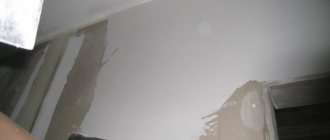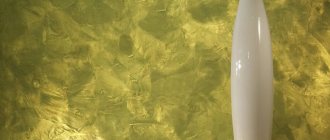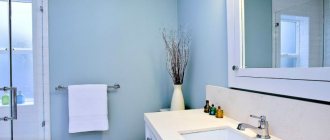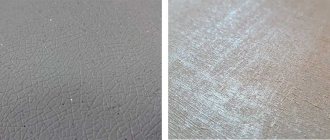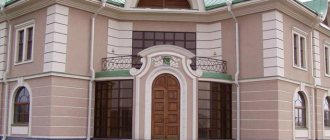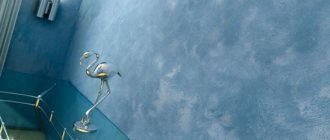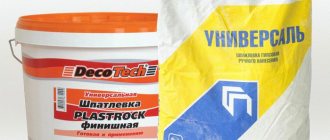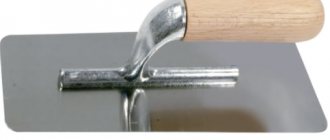What types of paints are there?
Paints are produced based on different materials. Depending on the main binding component, coatings are classified into the following types:
- latex;
- acrylic;
- silicone;
- alkyd;
- oil
Latex paint Parade Professional E3 Pro'Latex3 washable matte
Latex
The main component is latex polymer. Apply to plaster or wallpaper. But it cannot be used on a metal surface. It has no odor and dries quickly. A vulnerable property is low resistance to temperature changes.
Alkyd
An alkyd varnish coating forms a protective layer on the surface. The drying process occurs due to oxidation. It is characterized by wear resistance and high hydrophobicity. The material can be used to paint metal to prevent corrosion. The downside is that it is waterproof, which does not allow the treated surface to breathe.
Acrylic
The composition based on acrylic resins is highly wear-resistant. Suitable for interior use, including wet areas. The material dries quickly and has no odor. Certain types are used for facades.
Oily
The long-drying material is used mainly for outdoor work. The solvent is drying oil or oil. The coating can be applied to wood, concrete, plaster, and metal. The product is characterized by high resistance to moisture, aggressive environments and other adverse factors. The price of paint is affordable. A significant disadvantage is the presence of toxic substances in the composition.
Silicone
Coatings are made on the basis of silicone resins. Suitable solvents are water and water-dispersed removers. After application, it forms a thin film on the surface that is capable of allowing air to pass through. Due to its moisture resistance, it is used for interior work and painting facades. The disadvantage is the high cost.
Important Specifications
Any paint on the packaging contains information about what it is intended for (exterior, interior, facade, interior work; waterproof, wear-resistant). And these are not all the characteristics.
The following parameters are determined in laboratory conditions:
- degree of gloss;
- resistance to washing and mechanical stress;
- consumption, hiding power;
- drying time;
- adhesion;
- lifetime;
- thixotropy;
- environmental friendliness;
- light fastness;
- weather resistance, etc.
Information on technical characteristics helps you choose the right material for high-quality wall finishing in different rooms.
Gloss level of coating
The ability of paint to reflect light (shine) is called gloss. The degree of gloss is measured in production by instruments - gloss meters, which determine the amount of light reflected from the surface. Glass has a standard reflection (gloss level 100 units), and this paint indicator is determined as a percentage in relation to the glass indicators. Manufacturers indicate the established degree of gloss on the packaging using alphabetic or numerical symbols (for example, M - matte, PM - semi-matte, GM - deep matte). In numbers, this data is recorded with signs from 0 to 100 (for example, information on a can of 90-100 says that it contains paint with the highest gloss).
The gloss in the finish reveals the smallest defects on the surface, and this requires high quality preparation before painting, so we recommend using matte paints for walls.
Resistance to washing and mechanical stress
These are also important indicators of paint, and for latex wall paints they depend on the number of binding components per unit volume - latex and acrylic polymers. The test material is applied to the surface with a thickness of 25 microns and 200 passes are made with a wet brush, then the thickness of the lost layer is measured. The abrasion resistance rating is indicated on the packaging.
Additional properties
In addition to basic information about the composition of the paint, manufacturers indicate additional indicators that help select materials for finishing certain rooms.
Consumption
If we are talking about a water-based coating, then its consumption when finishing walls is approximately 150–200 g/m2 when applying one layer. To paint the surface well, you have to apply at least two layers. The number of passes depends on how the surface being treated absorbs the material. To correctly calculate the amount of paint, it is necessary to take into account the density of the material - how many kilograms are contained in one liter. For our water-based wall paints this figure is 1.4 kg/l.
Drying time
Buyers always pay attention to the drying time of the material. Different compositions dry differently - from 2 to 24 hours. Drying time depends on air temperature and humidity (optimal parameters +20 ° C at 65% humidity). The final polymerization of the paint applied to the surface and the acquisition of all specified properties occur within 7-14 days after application.
Covering power
The hiding power index is closely related to the paint consumption characteristics, since it determines the ability to hide the color of the base during application. Measured in grams of dried material required to cover one square meter of substrate for the original color to completely disappear from it. The indicator depends on the ratio of the filler, pigment and binder (particle size, quantity, etc.). High coverage rates guarantee low consumption.
Lifetime
The shelf life of ODISSEY coloring compositions is 24 months from the date of manufacture, provided that the materials are stored in accordance with storage recommendations. The exception is materials of class KM0 - for them the guaranteed shelf life is 6 months.
Adhesion
Indicator of adhesion of the composition to the treated surface. Adhesion is measured by the force of film separation from a unit area. Mechanical, chemical and electromagnetic forces of adhesion of the film to the surface are ensured by the introduction of special additives into the composition.
Composition of acrylic paints
The coating is made from acrylic copolymer monomers. Pigment and fillers are also used in production, giving the composition various properties.
Tips from TC "Kashirsky Dvor": How to choose paint for walls
Copolymers are essentially acrylic resins. To obtain a high-quality coating, resins with excellent characteristics are used.
Pigments are suitable from different origins: from organic to synthetic. They add opacity and color to the product. The dye is produced in the form of a dry fine powder.
The functions of fillers are to increase performance properties: adhesion, moisture resistance, matting, etc.
The solvent for acrylic coatings is water or an organic thinner.
Advantages and disadvantages
Acrylic compounds are widely used in repair and construction work. The popularity is due to the following advantages:
- environmental friendliness - no toxic substances hazardous to human health are used in the production of paint;
- ease of application - thanks to the consistency, elasticity and structure of the material, it is comfortable to work with;
- lack of odor is one of the main advantages of the coating over other paint and varnish products;
- fire safety - the composition does not include flammable materials, the painted surface does not spontaneously ignite;
- a wide choice of color solutions - thanks to pigments, it is easy to achieve the desired shade that supports the interior;
- drying speed – a surface coated with acrylic is ready for use after 1-3 hours;
- abrasion resistance, easy to care for - can be wiped with a dry or damp cloth;
- long operational period.
Surfaces painted with acrylic paint are vapor permeable, which means air will circulate through the walls and ceiling. Dirt does not accumulate on them, humidity does not provoke the formation of mold and mildew. Due to its physical properties, it is possible to use the coating indoors and on facades. The material goes well with other types of finishes.
When deciding to use acrylic paint, you need to take into account the disadvantages of the product. First of all, it is a high price. Although experts consider it completely justified. Other disadvantages include:
- during long-term storage, delamination of the material is possible;
- the difficulty of choosing a shade when mixing the base with pigment yourself;
- Cheap varieties quickly lose color when exposed to UV rays.
Toxic substances are not used in the manufacture of this material. However, unscrupulous manufacturers may add ammonia and other dangerous chemical compounds to reduce the cost of the product.
Color options
Painting walls has virtually unlimited possibilities for choosing colors, since paints can be tinted in the desired color to create a unique interior design. White paints for walls are far from the only solution, thanks to tinting. Correctly selected primary colors and shades will delight you for a long time and evoke only positive emotions. In design, when painting walls, several basic combinations are used:
- gradient combination of shades of the same color;
- a range of similar shades;
- contrasting combinations of different colors.
When making a choice in favor of one color scheme or another, it is necessary to take into account a number of points, among which the purpose of the room, its size, the desire to visually expand or reduce the space, and the lighting of the walls play an important role.
When choosing a color scheme, it is also necessary to take into account the influence of color on the psychology of people who are constantly in this space, since colors affect us differently. Too bright ones can quickly get boring and, instead of harmony and calm, you can get depression, anxiety, and drowsiness.
Remember that the paint acquires its true color only after complete drying. Therefore, it is necessary to select colors and shades from catalogs, do preliminary coloring of samples, check them in room conditions in combination with furniture, accessories, and look at changes in shades under different lighting. When choosing a range of colors for painting walls, contact a professional designer - they will help you find a solution. We, in turn, provide samples and colors of our materials for construction projects.
Characteristics
When choosing an acrylic coating, you should carefully read the technical characteristics and analyze important criteria.
| Manufacturer | You can not go wrong with the quality of the coating by choosing products from well-known brands. The products of the following companies deserve attention: Dulux, FARBITEX, LAKRA, DALI. |
| Application | On the label of each paint, the manufacturer indicates its purpose: façade, for walls/ceilings, baths and wet rooms, external and internal work. There are also universal options that can be used when performing any work. |
| Coverage type | The coating can be opaque or glaze. In the first case, the surface is densely painted even after one pass with a brush. In the second case, transparency is ensured. Glaze paints are used primarily for wood. |
| Washable or not | The material may include hydrophobic additives that allow the painted surface to be washed. Without them, cleansing is done using a dry method. |
| Processing material | When choosing paint, you need to consider the type of base. This determines how long the coating will last on a particular surface. The acrylic-based composition adheres well to drywall, stone, wood, brick, and plastered surfaces. |
| Heat resistance, frost resistance, moisture resistance | These indicators determine the purpose of the paint. It is important to consider them when choosing a façade covering. |
| Glossy or matte | After drying, the paint can form a glossy or matte surface. The variety is selected individually. The degree of gloss is determined as a percentage: - up to 5% - deeply matte, not giving shine; — 6-10% — matte, poorly reflecting light; — 11-29% – semi-matte, poorly reflecting light; — 30-59% — semi-gloss; — 60-89% — glossy with high shine; - from 90% - mirror shine. |
| Drying time | This type of coating has a high drying speed. The surface can be used after 1-3 hours. There are also quick-drying compositions that require only 20-30 minutes. |
| Color | The paint is available primarily in white. Using pigments you can achieve almost any shade. The components are mixed manually or on a special machine that selects the shade using a computer. Products are also available in a specific color. In production conditions, tinting is performed using a computer method. |
| Volume, l | Each manufacturer chooses its own packaging options. There are volumes ranging from 0.3 to 10 liters. |
| Weight, kg; | When choosing acrylic paint, it is important to correctly calculate the consumption. Some manufacturers indicate kilograms, others - liters. A 1 liter container contains 1.45-1.55 kg of coating. |
When choosing acrylic-based paint for different jobs, it is recommended to give preference to a universal composition.
Wall painting options
You can paint the walls in your apartment using putty using tinted varnishes, waxes or paints. Some plasters are offered by manufacturers tinted, while other materials are colored during the preparation process using pigments.
Taking into account the texture of the putty and the design project, you can use the following painting options:
- plain tinting of wall panels;
- tinting surfaces in several shades;
- painting walls to resemble polished marble and Venetian plaster;
- the “dry brush” technique allows you to create artificially natural unevenness on the base;
- toning with the effect of highlighting individual areas.
How to apply acrylic paint on a wall
It is recommended to work with acrylic paints using high-quality tools. Brushes should be prepared in different sizes so that the coating fits well in hard-to-reach places, corners and other areas. Rollers come in handy on long and short handles. When painting ceilings, it is better to use a telescopic handle.
It is better to choose a roller with a medium-length pile; with a short one, you will often dip it into the tray. A long one may result in uneven coloring of the surface. Do not use the same roller with different types of paint.
It is better to use a polyamide coat for the roller - it can be used with any paint and varnish materials, it is durable and resistant to aggressive environments.
